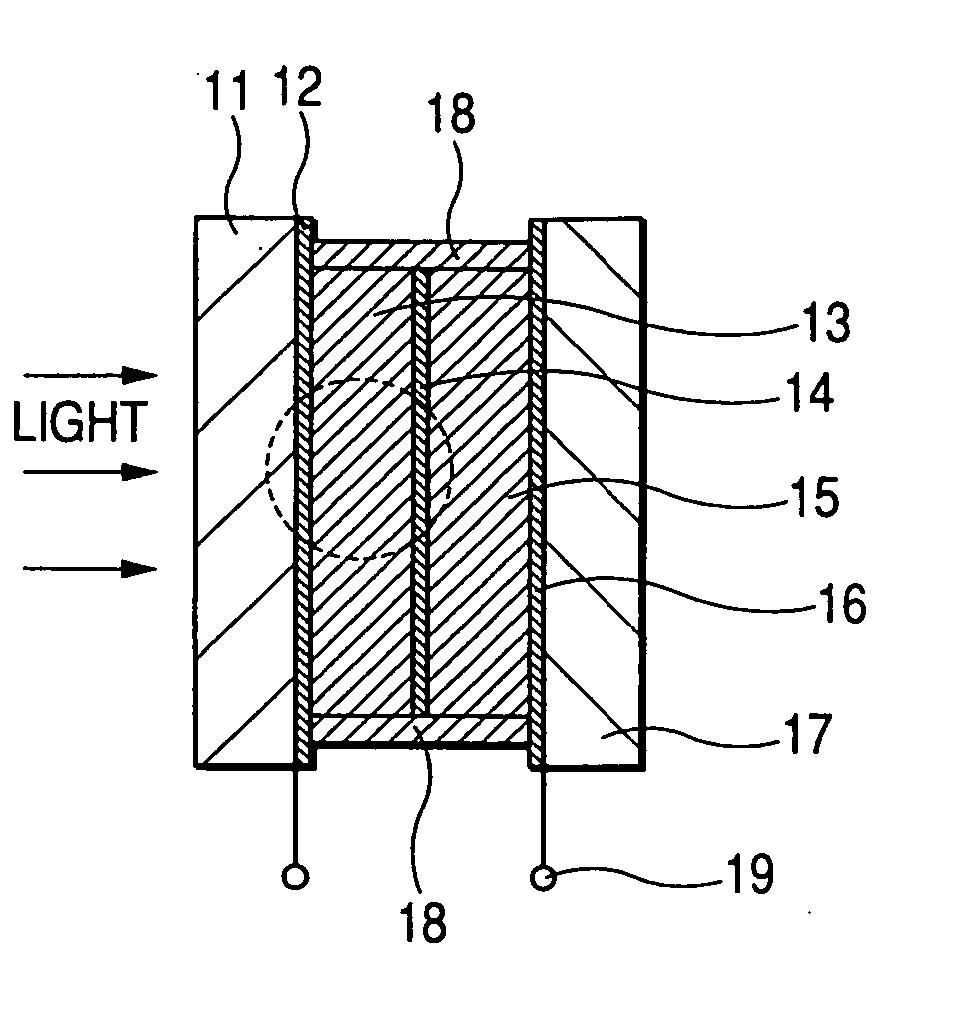Dye sensitization photoelectric converter and process for producing the same
a photoelectric converter and dye sensitization technology, applied in the direction of electrochemical generators, sustainable manufacturing/processing, final product manufacturing, etc., can solve the problems of concrete guide line for forming a complex, high economic cost and energy cost in a manufacturing process, and reduce energy conversion efficiency, so as to improve energy conversion efficiency
- Summary
- Abstract
- Description
- Claims
- Application Information
AI Technical Summary
Benefits of technology
Problems solved by technology
Method used
Image
Examples
embodiment 1
A Case in Which Semiconductor Layers Having Different Band Structures From One Another are Laminated
[0043]FIGS. 1A and 1B are a schematic cross-sectional diagram of an illustrative example of a dye-sensitized photochemical cell according to Embodiment 1 and an enlarged cross-sectional view of a major portion thereof taken along a broken line in the schematic cross-sectional diagram, respectively.
[0044] A transparent substrate 11 is a material having such a property and a shape as allow light to be easily transmitted; for example, a glass sheet or a transparent plastic sheet made of, for example, polyethylene terephthalate or polycarbonate is used. Since it is not necessary that the other substrate 17 is transmittable to light, an opaque glass sheet, a plastic sheet, ceramic sheet or metal sheet may be used.
[0045] On a surface of the transparent substrate 11, a transparent electrode 12 is formed as an electrode (negative electrode) for drawing an electron out. A material of the tr...
embodiment 2
A Case in Which Semiconductor Superfine Grains Having Different Band Structures From One Another are Laminated
[0057]FIG. 3 is an enlarged cross-sectional view of a major portion of a negative electrode according to Embodiment 2 of the invention. A schematic cross-sectional view of an entire dye-sensitized photochemical cell is same as in Embodiment 1 as shown in FIG. 1A and, accordingly, omitted.
[0058] In Embodiment 1, a case in which thin films of the semiconductor materials are laminated one on the other is shown, but, in Embodiment 2, a process comprising coating of a dispersion in a paste state containing superfine grains of the semiconductor material, evaporating of a dispersion medium and sintering of the superfine grains is repeatedly performed on a plurality of semiconductor materials, to thereby produce a laminate structure.
[0059] In a same manner as in Embodiment 1, by laminating a plurality of semiconductor materials having different band structures from one another on...
embodiment 3
A Semiconductor Layer (1) Comprising a Complex of a Titanium Oxide Thin Film Having a Drift Region of an Electron Inside and a Titanium Oxide Fine Grain
[0079] Hereinafter, with reference to FIGS. 4A to 4G, a manufacturing process of a semiconductor layer 33 comprising a complex of a titanium thin film having a drift region of an electron inside and a titanium oxide fine grain will be described.
Step 1
[0080] A thin film electrode 32 is formed on a surface of a substrate 31. As for the substrate 31, for example, a glass sheet is used. The thin film electrode 32 is, for example, a thin film of indium oxide doped with tin (ITO) or gold and is formed by a vapor deposition or sputtering.
Step 2
[0081] A TiO2 thin film 41 is formed on the substrate 31. Such film forming may be performed by sputtering or, otherwise, may be performed by a sol-gel method.
[0082] When the substrate 31 is titanium Ti, a TiO2 layer 41 may be formed by using an anodic oxidation coating.
Step 3
[0083] An impu...
PUM
| Property | Measurement | Unit |
|---|---|---|
| Thickness | aaaaa | aaaaa |
| Thickness | aaaaa | aaaaa |
| temperature | aaaaa | aaaaa |
Abstract
Description
Claims
Application Information
 Login to View More
Login to View More - R&D
- Intellectual Property
- Life Sciences
- Materials
- Tech Scout
- Unparalleled Data Quality
- Higher Quality Content
- 60% Fewer Hallucinations
Browse by: Latest US Patents, China's latest patents, Technical Efficacy Thesaurus, Application Domain, Technology Topic, Popular Technical Reports.
© 2025 PatSnap. All rights reserved.Legal|Privacy policy|Modern Slavery Act Transparency Statement|Sitemap|About US| Contact US: help@patsnap.com



